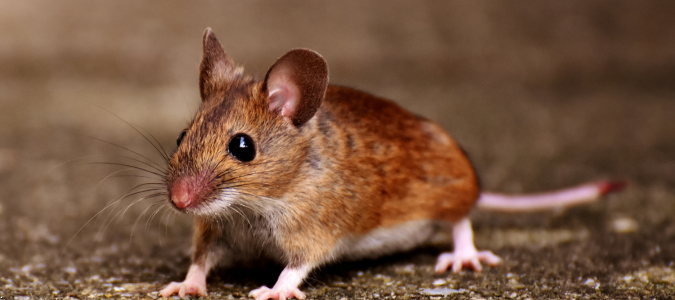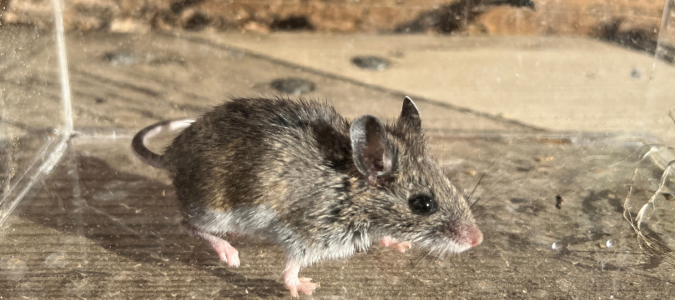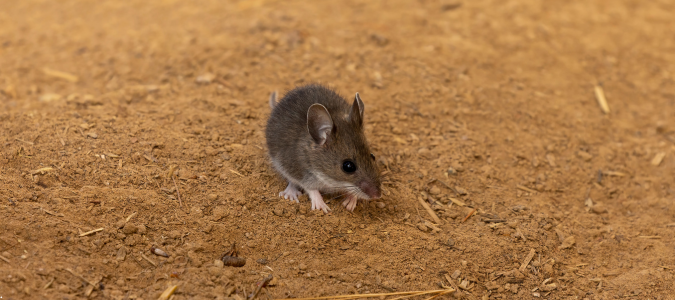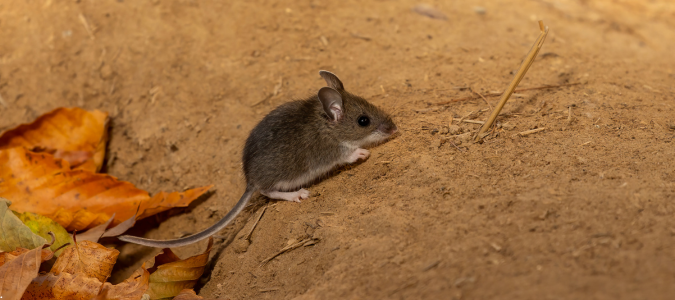Have you noticed signs of mice in your home? If so, you may want to know what type of mice is taking up residence in your home.
If you suspect that a mouse infestation is taking over your home, contact a pest control service.
Deer Mouse Versus House Mouse: Which Is the Bigger Pest?
Deer mice and house mice, pictured above, are two common rodents that homeowners encounter inside their houses. Deer mice transmit hantavirus, making them more of a problem than house mice. However, you’re more likely to find house mice in or around your home. It’s helpful for homeowners to understand the difference between deer mice and house mice so they can correctly identify a mouse infestation and take the proper steps to control it.
These two types of mice differ in three main ways:
- Appearance
- Behavior
- Nesting and habitat
Let’s examine these in more detail.
Deer Mouse Versus House Mouse: Appearance
Deer mice have two-toned fur that is either brown or gray on top and white on their underbellies and feet. Their tails are also two-toned and long, and they’re covered in fine hairs.
When it comes to facial features, deer mice are known for having large, beady eyes and large ears. Most deer mice measure between five and eight inches long, including their tails.
House mice, on the other hand, have solid-colored fur that’s either light brown or gray all over, including their feet and bellies. Their tail is typically just one color, and is scaly and hairless.
They have smaller eyes and ears than deer mice, and their facial features look more proportional. Including their tails, house mice measure between five and seven inches long.
Deer Mouse Versus House Mouse: Behavior
Both deer mice and house mice are nocturnal animals, so they are most active at night. However, while deer mice are timid and do not like to be seen in an open space, especially during the day, house mice are more bold. It’s more common to spot a house mouse scurrying through your home than it is for a deer mouse.
Deer mice are known for their climbing abilities. Despite this, they don’t typically venture far away from their nests. House mice, on the other hand, are known for chewing rather than climbing. They can cause significant damage to your drywall, wires and food packaging thanks to their large teeth.
Deer Mouse Versus House Mouse: Nest and Habitat
Deer mice prefer rural habitats, such as wooded or grassy areas. While they do enter homes to seek shelter, it’s more common to find them in sheds, barns and garages. You may also find deer mice in your garden. However, the warmth of a home is especially appealing to them during the cold months.
House mice get their name from infesting houses. These pests like to live near humans because they offer easy access to food, water and shelter. You’ll find their nests behind kitchen appliances, inside cabinets and within walls.
If you suspect that either of these mouse species has taken up residence in your home, contact a pest control professional.
Deer Mouse Versus House Mouse Droppings
One of the earliest signs of a mouse infestation is spotting their droppings around your home. In fact, it’s more common to spot mouse droppings than an actual mouse since they are nocturnal and try to stay hidden during the day. Most mice sleep during daylight hours and become active when the sun goes down.
Mouse droppings can also help you identify the species that you’re dealing with in your home. For example, both deer mice, pictured above, and house mice droppings are small, dark-colored and resemble a grain of rice. They also each measure between one-eighth and one-fourth of an inch long.
However, deer mouse droppings have pointed ends while house mouse droppings have blunt ends.
The most common place to find mouse droppings, regardless of species, is along the paths they travel frequently, such as between their nest and their food source. You may also spot droppings inside kitchen cabinets and drawers, under sinks, along your walls and behind furniture.
Some species also leave droppings in attics, garages and near cluttered storage spaces. Finally, it’s common to find mouse droppings near food storage areas.
If you spot mouse droppings around your home, contact a pest control specialist. Don’t wait to see an actual mouse before you take action.
What Is the Lifespan of a Deer Mouse?
The average lifespan of a deer mouse is between one and two years. Their survival depends on several factors, such as their proximity to predators, access to food and where they shelter. Deer mice that find a warm place to build their nests, such as an attic, live longer than those exposed to the elements.
House mice have shorter lifespans than deer mice. They live between six months and two years. The house mice that live outside tend to have a much shorter life than those that live in a home.
How many mice is considered an infestation? There’s no definitive number, but it’s important to understand that all mouse species reproduce rapidly and can quickly become a major problem for homeowners. If you suspect that there are mice in your home, reach out to a pest control specialist.
How To Get Rid of a Deer Mouse
The best way to get rid of deer mice is by working with a rodent control service. The experts have the right tools and expertise needed to control the infestation.
Deer mice reproduce rapidly and are difficult to remove without professional intervention. However, as a homeowner, you can take steps that will complement professional pest control services. For example, sealing up all potential mouse entry points to your home can help prevent another infestation.
Inspect around your home for gaps or cracks in your foundation, around doors, windows and siding. Deer mice only need an opening the size of a dime to fit through, so it’s important to be thorough.
Next, keeping your yard tidy can help keep deer mice off your property. These pests like to nest in debris, wood piles and tall grasses. The less hospitable your yard is, the smaller the chance that deer mice will find their way into your home.
Deer mice enter homes seeking a food source, so eliminating all potential options can go a long way in deterring them. Store all pantry goods, such as cereal and rice, in airtight containers made out of hard plastic or metal. Clean up all spills and crumbs immediately, and do not leave food out overnight. You should also take up pet food overnight and regularly empty your trash can.
Lastly, keeping your home decluttered is an important step. Clutter, especially in garages and attics, provides the perfect nesting conditions for deer mice. Keep these spaces organized and store all valuables in air-tight containers.
To kick deer mice out of your house, contact a pest control specialist. Along with taking care of the infestation, an expert can advise you on more prevention measures.
Control Deer Mice and House Mice With Expert Help
Mouse infestations of any kind can become a major problem for homeowners. Contact a pest control service if you suspect that a mouse infestation is in your home.
ABC Can Resolve Your Mouse Problem
It’s easy for a mouse infestation to get out of hand quickly if the proper interventions aren’t made. ABC’s pest control pros understand how to control rodents.




